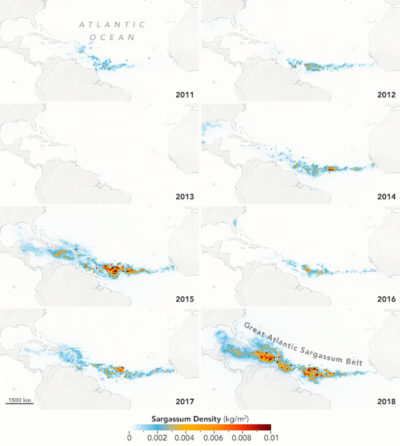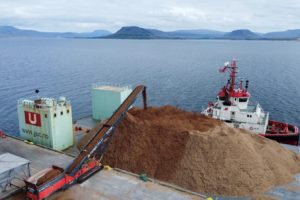Sargassum extent from July 2011 to July 2018. NASA/Earth Observatory. Data provided by Mengqiu Wang and Chuanmin Hu, USF College of Marine Science
Scientists have discovered a massive seaweed bloom stretching across nearly the entire Atlantic Ocean, from the west coast of Africa to the Gulf of Mexico. The bloom, dubbed the Great Atlantic Sargassum Belt, first appeared in 2011 and has become an almost yearly occurrence, fueled in part by an influx of nutrients washed out to sea from deforestation and farming in the Amazon, researchers reported in the journal Science.
Prior to 2011, most open-ocean Sargassum plants were found in small clumps around the Gulf of Mexico and Sargasso Sea. But in 2011, satellite images showed a near-constant string of the plants stretching across the entire tropical Atlantic Ocean. In subsequent years, the seaweed belt has gotten longer and thicker. Last year, the belt contained more than 20 million tons of Sargassum — heavier than 200 fully loaded aircraft carriers, according to NASA.
“I can say that the belt is very likely to be a new normal,” Chuanmin Hu, a marine scientist at the University of South Florida who helped lead the new study, said in a statement.
Sargassum provides critical habitat for marine animals such as turtles, crabs, fish, and birds, while also producing oxygen via photosynthesis. But scientists warned in a press release that too much of the seaweed can “make it hard for certain marine species to move or breathe,” can smother corals and seagrasses when it sinks to the ocean floor, and can release hydrogen sulfide gas when it washes ashore. Several countries, including Barbados, have declared national emergencies due to the amount of seaweed accumulating on their beaches and the toll it is taking on the tourism industry.
“The scale of these blooms is truly enormous,” said Woody Turner, manager of the Ecological Forecasting Program at NASA Headquarters in Washington.
When sargassum collects along coastlines and rots, such as seen here in Cancun in 2015, it gives off a rotten egg odor. Courtesy of Michael Owen
Hu and his colleagues found that several factors are responsible for the recent seaweed blooms: a large seed population left over from a previous bloom, nutrients from West Africa in the winter, and an input of new nutrients from the Amazon River. Sargassum also only grows abundantly when salinity and surface temperatures are normal. “The ocean’s chemistry must have changed in order for the blooms to get so out of hand,” Hu said. The scientists found that deforestation rates in the Amazon — and the subsequent expansion in farming and use of fertilizers — in particular helped to fuel bigger seaweed blooms.
“Earth’s ocean biogeochemistry is changing in response to natural and human forcings,” Paula Bontempi, acting deputy director of NASA’s Earth Science Division, said in a statement. “The Great Atlantic Sargassum Belt suggests that we may be witnessing ecosystem shifts in our ocean that could have important implications for marine organisms and ecosystem services, which humans depend on.”




